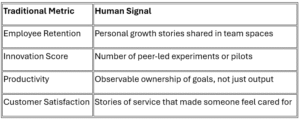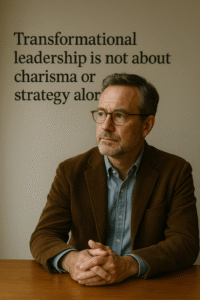Transformational leadership is a style that focuses less on controlling outcomes and more on inspiring lasting change in people, in teams and in culture.
In some teams, work feels like duty. In others, it feels like a shared responsibility, carried with pride. You hear laughter between deadlines and see juniors speaking up without fear. That’s no accident. It’s the quiet legacy of a leader who leads from the heart, not just the head.
These leaders do not just manage performance. They shape the way people think, feel and show up every day. They build trust, they encourage honesty and they make space for growth, not just professionally, but personally.
Long after they have moved on, you see traces of their leadership in how people show up for one another and how the work environment feels safer and more alive.
Let us look at how transformational leaders change the way people think, feel and work together—and why their real impact lives on in the culture they help create.
1. Psychological Safety as a Cultural KPI
In most organizations, psychological safety is treated as a soft value—something nice to have. But transformational leaders see it as the cultural bedrock. They understand that people do not innovate, disagree or grow in environments where they fear being ridiculed or reprimanded.
Rather than relying solely on engagement surveys or feedback forms, these leaders pay attention to subtler cues — the willingness to speak up, to admit failure, to express doubt, to challenge an idea without fear of consequence.

A close friend once shared this with me. When they first took over as Head of Department, they noticed their team rarely spoke up in meetings unless their ideas were perfectly polished. No one wanted to admit uncertainty or discuss what had not worked.
So they started something called “Failure Friday.” Every week, the team would take a few minutes to talk about something that had gone wrong, an idea that flopped, a client interaction that backfired, anything that felt uncomfortable to say out loud.
To break the ice, they shared the first story themselves. How a product direction they had championed in their previous role had completely missed the mark. They owned the mistake and reflected on what that experienced taught them.
Within a few weeks, something shifted. People laughed more. They shared more. Failure stopped being something to hide and became something to learn from. Risk-taking slowly turned into a cultural norm — not a threat to reputation, but a path to growth.
These micro-moments matter. Transformational leaders engineer them by:
• Asking curious questions instead of issuing directives.
• Publicly acknowledging mistakes to normalize learning.
• Creating “safe-to-fail” zones where experimentation is encouraged.
In doing so, they increase trust and the team feels safe.
2. Leadership as Emotional Pattern Disruption
Every organization has emotional undercurrents: blame cycles, silence in the face of conflict, a reluctance to share credit. Transformational leaders identify these patterns and then intentionally disrupt them.
Not through grand speeches, but through subtle emotional cues:
• Using humour to diffuse defensiveness
• Holding silence to invite reflection
• Choosing transparency when it would be easier to deflect
These leaders model emotional fluency. They do not just speak about empathy or resilience, they embody it. And in doing so, they begin to reset the emotional rhythms of the group. Where there was tension, there is now room to breathe. Where there was avoidance, there is the possibility of truth.
3. Culture Transfer, Not Just Culture Fit
The idea of hiring for “culture fit” can become a shortcut for hiring sameness. Transformational leaders flip the script. They seek culture expansion, bringing in individuals who stretch the organization’s thinking, challenge assumptions, and bring new rituals to life.
They treat culture like an urban garden—messy, organic, diverse. Growth does not happen through monoculture but through cross-pollination.
 A healthcare startup CEO brought in a daily practice: rotating team leads for stand-up meetings. Each day, a different person, regardless of role or title would guide the morning check-in. The idea was to build shared ownership, boost confidence, and surface quieter voices. Initially, some team members were hesitant, unsure if they had the ‘right’ to lead. But over time, it became a norm. Juniors began taking the lead with ease, cross-functional collaboration improved, and it subtly dismantled old hierarchies.
A healthcare startup CEO brought in a daily practice: rotating team leads for stand-up meetings. Each day, a different person, regardless of role or title would guide the morning check-in. The idea was to build shared ownership, boost confidence, and surface quieter voices. Initially, some team members were hesitant, unsure if they had the ‘right’ to lead. But over time, it became a norm. Juniors began taking the lead with ease, cross-functional collaboration improved, and it subtly dismantled old hierarchies.
These leaders seed new habits—peer feedback huddles, daily gratitude shoutouts, reverse mentoring—that outlive their tenure and embed adaptability into the system.
4. The Role of Shadow Leadership
One of the least talked-about but most powerful aspects of transformational leadership is the cultivation of shadow leaders. They are informal influencers who transmit values through lunchroom conversations, group chats or mentoring juniors.
There is a store I visit quite often. One of the floor staff there stands out—not because of his title, but because of how he shows up. He greets every customer with a genuine smile, starts easy conversations to make people feel at home, and gives them space instead of hovering. Over time, I noticed that both regulars and new customers naturally gravitate towards him. They feel comfortable asking him questions. He makes the experience feel human.
What struck me during my last visit was how his colleagues had started doing the same. That energy had spread. The store was buzzing. And it was not because of any new policy, it was because someone quietly modelled a better way of showing up and others followed.
Transformational leaders recognise these invisible carriers of culture and nurture them by:
- Giving them voice without requiring a title
- Reinforcing their behaviours as symbolic leadership
- Involving them as early adopters of cultural shifts
- Often, it is these shadow leaders who carry forward the ethos long after the formal leader has moved on.
5. Designing Cultural Feedback Loops
There was a Project Manager I worked with once who did something quite brilliant. At the end of each big project, instead of jumping straight into performance reviews or lessons learned, they would hold a simple ritual they called “Behind the Scenes.”
 Each person named one teammate whose quiet effort had made a real difference, someone who may not have been visible, but who mattered deeply.
Each person named one teammate whose quiet effort had made a real difference, someone who may not have been visible, but who mattered deeply.
The first time they tried it, people were a bit unsure. Was this really part of the process? But then the stories started coming out. About someone who kept the team grounded when things got chaotic. Someone who fixed a last-minute glitch without making a fuss. Someone who checked in on a colleague having a tough week.
By the time they wrapped up, the room felt different. Warmer. More connected. And they kept doing it, after every major milestone. No forms, no slides. Just people remembering to notice each other.
That is what transformational leaders do. They do not wait for feedback to show up in forms or dashboards. Instead, they weave it into everyday culture, so that noticing, appreciating and learning becomes part of how the team breathes.
They build feedback loops like:
• Storytelling circles that surface moments of courage or care
• Peer recognitions that honour effort, not just outcomes
• Creative showcases where process gets as much attention as product
These loops become the nervous system of the culture—responding, adapting, evolving in real time. They create shared memory, reinforce values and build belonging in ways that spreadsheets never can.
6. From Metrics to Meaning: Reframing KPIs
Most company dashboards are like fitness trackers. They count your steps, measure your heart rate, and tell you how many calories you burned. What they cannot tell you is whether you actually felt good doing it or not. Whether the run left you energised or exhausted. Was it meaningful or just mechanical.
That is where transformational leaders shift their lens. They do not just track motion, they listen for emotion.
Instead of asking, “Did we hit the target?” they ask, “What did it take to get there and how did it feel?”
They look for signs that rarely show up in quarterly reports:
• A teammate showing up with new confidence after failure
• A junior employee disagreeing because they finally feel safe
• Support offered before it was asked for
These are not metrics. They are meaning.

Because culture is not just about how far you have walked. It is about whether people want to keep walking with you.
Final Word: Leaders as Cultural Engineers
 Ultimately, transformational leadership is not about charisma or strategy alone. It is about the emotional architecture a leader leaves behind:
Ultimately, transformational leadership is not about charisma or strategy alone. It is about the emotional architecture a leader leaves behind:
• A team that dares to speak.
• A space that holds learning and failure with equal grace.
• A culture that outgrows its creator.
In a world obsessed with short-term wins, these leaders play a long game. They do not just build for Q4—they build for the next generation of thinking, being, and leading.
Their real KPI? The culture that continues to breathe, grow, and evolve—even after they have gone.
To know more about how The Yellow Spot can help you on your Learning journey, Visit ‘https://www.theyellowspot.com’ for more info or reach out at info@theyellowspot.com / India: +91 99677 14310, +91 87792 84314
#leadership skills # First Time Managers Training # Customer Centricity # Effective Communication # corporate training # best corporate training companies # Time Management # Ownership & Accountability





